Design and Implementation of SEMAR IoT Server Platform with Applications
Abstract
:1. Introduction
2. Related Works
3. Design of SEMAR IoT Server Platform
3.1. System Overview
3.2. Data Input
3.3. Data Process
3.3.1. Data Management (Storage, Aggregator, and Plug-in Functions)
| Algorithm 1 Data aggregator |
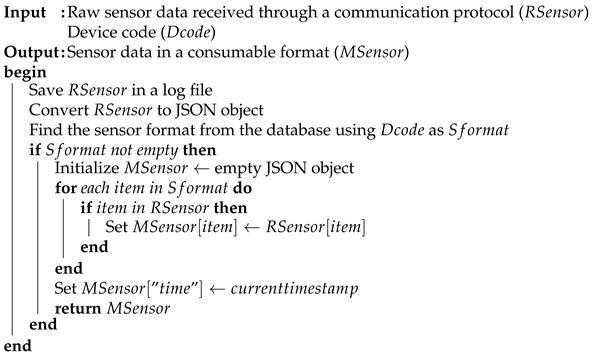 |
3.3.2. Data Filter and Synchronization
- It receives sensor data in a JSON format.
- It selects the sensor field’s value to be filtered.
- It add the field value in the JSON object with the filter result.
- It stores the JSON object in the database.
- Average: it returns the average value of the data collected during the detection time.
- Current: it returns the last value among the data collected during the detection time.
- Max: it returns the highest value among the data collected during the detection time.
- Min: it returns the lowest value among the data collected during the detection time.
| Algorithm 2 Data Synchronization |
 |
3.3.3. Machine Learning and Real-time Classification
- Maximum depth (): represents the maximum depth of the tree model result. It is used to select the optimal model to prevent over-fitting.
- Minimum samples split (): represents the minimal amount of data required to separate an internal node. If it is large, it can prevent over-fitting; however, if it is very large, it can cause under-fitting.
- Minimum samples leaf (): represents the minimal amount of data required to be left at the leaf node. It is similar to the minimum samples split parameter.
- Minimum weighted fraction leaf (): represents the total weight required at a leaf node.
- Kernel: represents the function of transforming the training dataset into the higher dimension space. The standard kernel consists of Radial Basis Function (RBF), linear, polynomials, and sigmoid.
- C: represents the penalty parameter that controls the trade-off between the decision boundary and the misclassification. C value controls the margin of the decision boundary line to avoid misclassifications. The large value can prevent the model from allowing any misclassification. If the dataset is linearly separable, it will work; however, if the dataset is non-separable/nonlinear, it is better to use a small C value to avoid overfitting, although it allows misclassifications to occur.
- Gamma: represents the coefficient of the kernel used to decide the curvature of the decision boundary line. The value of Gamma determines the shape of the decision boundary line according to the number of dataset points. The large value causes the decision boundary to be easily affected by fewer data points, and the shape becomes complex. It can be helpful for nonlinear datasets; however, if it is too large, it tends to be over-fitting. On the other hand, for the linear dataset, the small values make the decision boundary line more general and useful.
- 1.
- It loads the data classification model made by the machine learning algorithm.
- 2.
- It receives sensor data from the database.
- 3.
- It classifies data into classes by running the data model.
- 4.
- It stores results in the database.
3.4. Data Output
3.5. Management Service
4. Implementation of SEMAR IoT Server Platform
5. Integration of Air Quality Monitoring System
5.1. System Architecture
5.2. Implementation in Platform
6. Integration of Water Quality Monitoring System
6.1. System Architecture
6.2. Implementation in Platform
7. Integration of Road Condition Monitoring System
7.1. System Architecture
7.2. Implementation in Platform
8. Integration of Air-conditioning Guidance System
8.1. System Architecture
8.2. Implementation in Platform
9. Integration of Fingerprint-based Indoor Localization System
9.1. System Architecture
9.2. Calibration Phase
9.3. Detection Phase
9.4. Implementation in Platform
10. Evaluations
10.1. Performance Analysis
10.2. The State-of-the-Art Comparative Analysis
- IoT application: represents the IoT application that is covered or implemented in each work.
- Device management: indicates the capability of the IoT platform to manage devices (Yes or No).
- Communication protocol: describes the communication protocol utilized in each work.
- Data synchronization: implies the capability to synchronize data across several devices (Yes or No).
- Data filtering function: indicates the implementation of digital filters to process data (Yes or No).
- Decision-making assistance: indicates the implementation of tools to evaluate data or generate alerts based on data obtained (Yes or No).
- Flexibility: shows the abilities to allow to join new devices, to handle different communication settings, to define data types, and to easily interact with external systems (Yes or No).
- Interoperability: represents the ability to be integrated with plural external systems through defined protocols (Yes or No).
- Scalability: demonstrates the capability of processing a number of data simultaneously (Yes or No).
10.2.1. IoT Application
10.2.2. IoT Device Management
10.2.3. Communication Protocol
10.2.4. Decision Making Assistance
10.2.5. Interoperability and Flexibility
11. Threats to Validity
- Internal validity threat: validates the potential errors in the SEMAR implementation. In this study, SEMAR is integrated with five different IoT application systems. Each IoT application utilized various kinds of sensors. Possible threats may occur when submitting invalid or incomplete data. Moreover, the integration of SEMAR with the fingerprint-based indoor localization system requires the synchronization of data from each receiver to determine the location of the transmitter. To eliminate potential threats, SEMAR checks sensor data with the format. In addition, the data synchronization function will provide default values for devices with no data within the data synchronization timeframe.
- External validity threat: validates the generalization ability of the obtained results. We compare the results of SEMAR to those of previous IoT-related studies. The primary potential external threat revealed by the comparison results is that not all of the related IoT-related research provided comprehensive and clear explanations of the proposals.
12. Conclusions
Author Contributions
Funding
Institutional Review Board Statement
Informed Consent Statement
Data Availability Statement
Acknowledgments
Conflicts of Interest
References
- Theofilou, P. Quality of Life: Definition and Measurement. Eur. J. Psychol. 2013, 9, 150–162. [Google Scholar] [CrossRef]
- Macke, J.; Casagrande, R.; Sarate, J.; Silva, K. Smart City and Quality of Life: Citizens’ perception in a Brazilian case study. J. Clean. Prod. 2018, 182, 717–726. [Google Scholar] [CrossRef]
- Noura, M.; Atiquzzaman, M.; Gaedke, M. Interoperability in Internet of Things: Taxonomies and Open Challenges. Mob. Networks Appl. 2018, 24, 796–809. [Google Scholar] [CrossRef]
- Cubo, J.; Nieto, A.; Pimentel, E. A Cloud-Based Internet of Things Platform for Ambient Assisted Living. Sensors 2014, 14, 14070–14105. [Google Scholar] [CrossRef]
- Leong, W.; Kelani, R.; Ahmad, Z. Prediction of Air Pollution Index (API) using Support Vector Machine (SVM). J. Environ. Chem. Eng. 2020, 8, 103208. [Google Scholar] [CrossRef]
- Perlmutt, L.; Cromar, K. Comparing Associations of Respiratory Risk for The EPA Air Quality Index and Health-Based Air Quality Indices. Atmos. Environ. 2019, 202, 1–7. [Google Scholar] [CrossRef]
- MQTT Org. Message Queuing Telemetry Transport Protocol. Available online: http://mqtt.org/ (accessed on 12 May 2022).
- Kamienski, C.; Prati, R.; Kleinschmidt, J.; Soininen, J.P. Designing an Open IoT Ecosystem. In Proceedings of the Workshop on Cloud Networks 2019, Belem, Brazil, 16 July 2019. [Google Scholar]
- Bansal, S.; Kumar, D. IoT Ecosystem: A Survey on Devices, Gateways, Operating Systems, Middleware and Communication. Int. J. Wirel. Inf. Netw. 2020, 27, 340–364. [Google Scholar] [CrossRef]
- Li, S.; Xu, L.; Zhao, S. The Internet of Things: A Survey. Inf. Syst. Front. 2014, 17, 243–259. [Google Scholar] [CrossRef]
- Malche, T.; Maheshwary, P.; Kumar, R. Environmental Monitoring System for Smart City Based on Secure Internet of Things (IoT) Architecture. Wirel. Pers. Commun. 2019, 107, 2143–2172. [Google Scholar] [CrossRef]
- Venkanna, U.; Sharma, S.; Katiyar, B.; Prashanth, Y. A Wireless Sensor Node Based Efficient Parking Slot Availability Detection System for Smart Cities. In Proceedings of the 2018 Recent Advances on Engineering, Technology and Computational Sciences (RAETCS), Allahabad, India, 6–8 February 2018; pp. 1–6. [Google Scholar]
- Zhang, Q.; Zhong, H.; Shi, W.; Liu, L. A Trusted and Collaborative Framework for Deep Learning in IoT. Comput. Netw. 2021, 193, 108055. [Google Scholar] [CrossRef]
- Jain, V.; Ahuja, A.; Saini, D. Evaluation and Performance Analysis of Apache Pulsar and NATS. In Cyber Security and Digital Forensics; Lecture Notes on Data Engineering and Communications Technologies; Springer: Singapore, 2021; pp. 179–190. [Google Scholar] [CrossRef]
- Dizdarević, J.; Carpio, F.; Jukan, A.; Masip-Bruin, X. A Survey of Communication Protocols for Internet of Things and Related Challenges of Fog and Cloud Computing Integration. ACM Comput. Surv. 2019, 51, 1–29. [Google Scholar] [CrossRef]
- Marques, G.; Pitarma, R. An Internet of Things-Based Environmental Quality Management System to Supervise the Indoor Laboratory Conditions. Appl. Sci. 2019, 9, 438. [Google Scholar] [CrossRef]
- Benammar, M.; Abdaoui, A.; Ahmad, S.; Touati, F.; Kadri, A. A Modular IoT Platform for Real-Time Indoor Air Quality Monitoring. Sensors 2018, 18, 581. [Google Scholar] [CrossRef] [PubMed]
- Mandava, T.; Chen, S.; Isafiade, O.; Bagula, A. An IoT Middleware for Air Pollution Monitoring in Smart Cities: A Situation Recognition Model. In Proceedings of the IST Africa 2018 Conference, Gabarone, Botswana, 9–11 May 2018. [Google Scholar]
- Senozètnik, M.; Herga, Z.; Šubic, T.; Bradeško, L.; Kenda, K.; Klemen, K.; Pergar, P.; Mladenić, D. IoT Middleware for Water Management. Proceedings 2018, 2, 696. [Google Scholar] [CrossRef]
- Kazmi, A.; Serrano, M.; Soldatos, J. VITAL-OS: An Open Source IoT Operating System for Smart Cities. IEEE Commun. Stand. Mag. 2018, 2, 71–77. [Google Scholar] [CrossRef]
- Toma, C.; Alexandru, A.; Popa, M.; Zamfiroiu, A. IoT Solution for Smart Cities’ Pollution Monitoring and the Security Challenges. Sensors 2019, 19, 3401. [Google Scholar] [CrossRef] [PubMed]
- Javed, A.; Malhi, A.; Kinnunen, T.; Framling, K. Scalable IoT Platform for Heterogeneous Devices in Smart Environments. IEEE Access 2020, 8, 211973–211985. [Google Scholar] [CrossRef]
- The Apache Cassandra Software Project Website. Available online: https://cassandra.apache.org/ (accessed on 22 August 2022).
- Badii, C.; Bellini, P.; Difino, A.; Nesi, P. Smart city IoT Platform Respecting GDPR Privacy and Security Aspects. IEEE Access 2020, 8, 23601–23623. [Google Scholar] [CrossRef]
- Putra, K.; Chen, H.; Prayitno; Ogiela, M.; Chou, C.; Weng, C.; Shae, Z. Federated Compressed Learning Edge Computing Framework with Ensuring Data Privacy for PM2.5 Prediction in Smart City Sensing Applications. Sensors 2021, 21, 4586. [Google Scholar] [CrossRef]
- Gautam, G.; Sharma, G.; Magar, B.; Shrestha, B.; Cho, S.; Seo, C. Usage of IoT Framework in Water Supply Management for Smart City in Nepal. Appl. Sci. 2021, 11, 5662. [Google Scholar] [CrossRef]
- Oliveira, F.; Costa, D.; Lima, L.; Silva, I. iBikeSafe: A Multi-Parameter System for Monitoring, Evaluation and Visualization of Cycling Paths in Smart Cities Targeted at Cycling Adverse Conditions. Smart Cities 2021, 4, 56. [Google Scholar] [CrossRef]
- Metia, S.; Nguyen, H.; Ha, Q. IoT-Enabled Wireless Sensor Networks for Air Pollution Monitoring with Extended Fractional-Order Kalman Filtering. Sensors 2021, 21, 5313. [Google Scholar] [CrossRef] [PubMed]
- Twahirwa, E.; Rwigema, J.; Datta, R. Design and Deployment of Vehicular Internet of Things for Smart City Applications. Sustainability 2021, 14, 176. [Google Scholar] [CrossRef]
- D’Ortona, C.; Tarchi, D.; Raffaelli, C. Open-Source MQTT-Based End-to-End IoT System for Smart City Scenarios. Future Internet 2022, 14, 57. [Google Scholar] [CrossRef]
- Kumar, P.; Gupta, G.; Tripathi, R. Design of Anomaly-Based Intrusion Detection System Using Fog Computing for IoT Network. Autom. Control. Comput. Sci. 2021, 55, 137–147. [Google Scholar] [CrossRef]
- Kumar, P.; Gupta, G.; Tripathi, R. A Distributed Ensemble Design Based Intrusion Detection System Using Fog Computing to Protect The Internet of Things Networks. J. Ambient. Intell. Humaniz. Comput. 2020, 12, 9555–9572. [Google Scholar] [CrossRef]
- Kumar, P.; Gupta, G.; Tripathi, R. Toward Design of an Intelligent Cyber Attack Detection System using Hybrid Feature Reduced Approach for IoT Networks. Arab. J. Sci. Eng. 2021, 46, 3749–3778. [Google Scholar] [CrossRef]
- Kumar, P.; Gupta, G.; Tripathi, R. PEFL: Deep Privacy-Encoding-Based Federated Learning Framework for Smart Agriculture. IEEE Micro 2022, 42, 33–40. [Google Scholar] [CrossRef]
- Kumar, P.; Tripathi, R.P.; Gupta, G. P2IDF: A Privacy-preserving Based Intrusion Detection Framework for Software Defined Internet of Things-fog (SDIoT-Fog). In Proceedings of the 2021 International Conference on Distributed Computing and Networking, Nara, Japan, 5–8 January 2021; pp. 37–42. [Google Scholar]
- Wu, H.; Chen, C.; Weng, K. Two Designs of Automatic Embedded System Energy Consumption Measuring Platforms Using GPIO. Appl. Sci. 2020, 10, 4866. [Google Scholar] [CrossRef]
- Munshi, A. Improved MQTT Secure Transmission Flags in Smart Homes. Sensors 2022, 22, 2174. [Google Scholar] [CrossRef]
- Dinculeană, D.; Cheng, X. Vulnerabilities and Limitations of MQTT Protocol Used between IoT Devices. Appl. Sci. 2019, 9, 848. [Google Scholar] [CrossRef]
- Al-Joboury, I.; Al-Hemiary, E. IoT-F2CDM-LB: IoT Based Fog-to-Cloud and Data-in-Motion Architectures with Load Balancing. EAI Endorsed Trans. Internet Things 2018, 4, 155332. [Google Scholar] [CrossRef]
- Waseem, M.; Liang, P.; Shahin, M. A Systematic Mapping Study on Microservices Architecture in DevOps. J. Syst. Softw. 2020, 170, 110798. [Google Scholar] [CrossRef]
- Fridelin, Y.; Ulil Albaab, M.; Anom Besari, A.; Sukaridhoto, S.; Tjahjono, A. Implementation of Microservice Architectures on SEMAR Extension for Air Quality Monitoring. In Proceedings of the 2018 International Electronics Symposium on Knowledge Creation and Intelligent Computing (IES-KCIC) 2018, Bali, Indonesia, 29–30 October 2018; pp. 218–224. [Google Scholar]
- Kumar, P.; Gupta, G.; Tripathi, R.; Garg, S.; Hassan, M. DLTIF: Deep Learning-Driven Cyber Threat Intelligence Modeling and Identification Framework in IoT-Enabled Maritime Transportation Systems. IEEE Trans. Intell. Transp. Syst. 2021, 1–10. [Google Scholar] [CrossRef]
- Kumar, P.; Kumar, R.; Gupta, G.; Tripathi, R. BDEdge: Blockchain and Deep-Learning for Secure Edge-Envisioned Green CAVs. IEEE Trans. Green Commun. Netw. 2022, 1330–1339. [Google Scholar] [CrossRef]
- Kumar, P.; Gupta, G.; Tripathi, R. TP2SF: A Trustworthy Privacy-Preserving Secured Framework for Sustainable Smart Cities by Leveraging Blockchain and Machine learning. J. Syst. Archit. 2021, 115, 101954. [Google Scholar] [CrossRef]
- Kumar, P.; Gupta, G.; Tripathi, R. An Ensemble Learning and Fog-cloud Architecture-driven Cyber-attack Detection Framework for IoMT Networks. Comput. Commun. 2021, 166, 110–124. [Google Scholar] [CrossRef]
- Chang, C.; Lin, C. LIBSVM: A Library for Support Vector Machines. ACM Trans. Intell. Syst. Technol. 2011, 2, 1–27. [Google Scholar] [CrossRef]
- Suárez Sánchez, A.; García Nieto, P.; Riesgo Fernández, P.; del Coz Díaz, J.; Iglesias-Rodríguez, F. Application of an SVM-based regression model to the air quality study at local scale in the Avilés urban area (Spain). Math. Comput. Model. 2011, 54, 1453–1466. [Google Scholar] [CrossRef]
- Ghiasi, M.; Zendehboudi, S. Decision Tree-Based Methodology to Select a Proper Approach for Wart Treatment. Comput. Biol. Med. 2019, 108, 400–409. [Google Scholar] [CrossRef]
- Hagan, D.; Isaacman-VanWertz, G.; Franklin, J.; Wallace, L.; Kocar, B.; Heald, C.; Kroll, J. Calibration and Assessment of Electrochemical Air Quality Sensors by Co-Location with Regulatory-Grade Instruments. Atmos. Meas. Tech. 2018, 11, 315–328. [Google Scholar] [CrossRef]
- Wei, W.; Ramalho, O.; Malingre, L.; Sivanantham, S.; Little, J.; Mandin, C. Machine Learning and Statistical Models for Predicting Indoor Air Quality. Indoor Air 2019, 29, 704–726. [Google Scholar] [CrossRef] [PubMed]
- Ghosh, S.; Dasgupta, A.; Swetapadma, A. A Study on Support Vector Machine Based Linear and Non-Linear Pattern Classification. Proceedings of International Conference on Intelligent Sustainable Systems (ICISS) 2019, Palladam, India, 21–22 February 2019; pp. 24–28. [Google Scholar]
- MQTT Mosquitto Server. Available online: https://mosquitto.org/ (accessed on 12 May 2022).
- Dory, M.; Parrish, A.; Berg, B. Introduction to Tornado; O’Reilly Media: Sebastopol, CA, USA, 2012. [Google Scholar]
- MongoDB, Mongodb: The Application Data Platform. Available online: https://www.mongodb.com/ (accessed on 12 May 2022).
- Hao, J.; Ho, T. Machine Learning Made Easy: A Review of Scikit-learn Package in Python Programming Language. J. Educ. Behav. Stat. 2019, 44, 348–361. [Google Scholar] [CrossRef]
- Gamma, E.; Helm, R.; Johnson, R.; Vlissides, J.M. Design Patterns: Elements of Reusable Object-Oriented Software; Addison-Wesley Professional; Addison-Wesley: Boston, MA, USA, 1994. [Google Scholar]
- Villán, A.F. Mastering OpenCV 4 with Python: A Practical Guide Covering Topics from Image Processing, Augmented Reality to Deep Learning with OpenCV 4 and Python 3.7; Packt Publishing Ltd.: Birmingham, UK, 2019. [Google Scholar]
- Pang, B.; Nijkamp, E.; Wu, Y. Deep Learning With TensorFlow: A Review. J. Educ. Behav. Stat. 2019, 45, 227–248. [Google Scholar] [CrossRef]
- Huda, S.; Funabiki, N.; Kuribayashi, M.; Sudibyo, R.; Ishihara, N.; Kao, W. A Proposal of Air-Conditioning Guidance System Using Discomfort Index. In Proceedings of the 15th International Conference on Broad-Band and Wireless Computing, Communication and Applications (BWCCA-2020), Yonago, Japan, 28–30 October 2020; pp. 154–165. [Google Scholar]
- OpenWeatherMap. Current Weather and Forecast—OpenWeatherMap. Available online: https://openweathermap.org/ (accessed on 12 May 2022).
- Huo, Y.; Puspitaningayu, P.; Funabiki, N.; Hamazaki, K.; Kuribayashi, M.; Kojima, K.A. Proposal of the Fingerprint Optimization Method for the Fingerprint-Based Indoor Localization System with IEEE 802.15.4 Devices. Information 2022, 13, 211. [Google Scholar] [CrossRef]
- Puspitaningayu, P.; Huo, Y.; Funabiki, N.; Hamazaki, K.; Kuribayashi, M.; Kao, W. Investigations of Detection Accuracy Improvements for Fingerprint-based Indoor Localization System Using IEEE 802.15.4. In Proceedings of the Fourth International Conference on Vocational Education and Electrical Engineering (ICVEE) 2021, Surabaya, Indonesia, 2–3 October 2021; pp. 1–5. [Google Scholar]
- Mono Wireless. Mono Wireless Product Information. Available online: https://mono-wireless.com/jp/products/index.html (accessed on 12 May 2022).
- Hernández-Rojas, D.; Fernández-Caramés, T.; Fraga-Lamas, P.; Escudero, C. A Plug-and-Play Human-Centered Virtual TEDS Architecture for the Web of Things. Sensors 2018, 18, 2052. [Google Scholar] [CrossRef]
- Kamienski, C.; Soininen, J.; Taumberger, M.; Dantas, R.; Toscano, A.; Salmon Cinotti, T.; Filev Maia, R.; Torre Neto, A. Smart Water Management Platform: IoT-Based Precision Irrigation for Agriculture. Sensors 2019, 19, 276. [Google Scholar] [CrossRef]
- Chiesa, G.; Cesari, S.; Garcia, M.; Issa, M.; Li, S. Multisensor IoT Platform for Optimising IAQ Levels in Buildings through a Smart Ventilation System. Sustainability 2019, 11, 5777. [Google Scholar] [CrossRef]
- De M. Del Esposte, A.; Santana, E.; Kanashiro, L.; Costa, F.; Braghetto, K.; Lago, N.; Kon, F. Design and Evaluation of a Scalable Smart City Software Platform with Large-Scale Simulations. Future Gener. Comput. Syst. 2019, 93, 427–441. [Google Scholar] [CrossRef]
- Christou, I.; Kefalakis, N.; Zalonis, A.; Soldatos, J.; Bröchler, R. End-to-End Industrial IoT Platform for Actionable Predictive Maintenance. IFAC-PapersOnLine 2020, 53, 173–178. [Google Scholar] [CrossRef]
- Marcu, I.; Suciu, G.; Bălăceanu, C.; Vulpe, A.; Drăgulinescu, A. Arrowhead Technology for Digitalization and Automation Solution: Smart Cities and Smart Agriculture. Sensors 2020, 20, 1464. [Google Scholar] [CrossRef] [PubMed]
- Trilles, S.; González-Pérez, A.; Huerta, J. An IoT Platform Based on Microservices and Serverless Paradigms for Smart Farming Purposes. Sensors 2020, 20, 2418. [Google Scholar] [CrossRef] [PubMed]
- Boursianis, A.; Papadopoulou, M.; Gotsis, A.; Wan, S.; Sarigiannidis, P.; Nikolaidis, S.; Goudos, S. Smart Irrigation System for Precision Agriculture—The AREThOU5A IoT Platform. IEEE Sens. J. 2021, 21, 17539–17547. [Google Scholar] [CrossRef]
- Antunes, M.; Santiago, A.; Manso, S.; Regateiro, D.; Barraca, J.; Gomes, D.; Aguiar, R. Building an IoT Platform Based on Service Containerisation. Sensors 2021, 21, 6688. [Google Scholar] [CrossRef]
- Depari, A.; Fernandes Carvalho, D.; Bellagente, P.; Ferrari, P.; Sisinni, E.; Flammini, A.; Padovani, A. An IoT Based Architecture for Enhancing the Effectiveness of Prototype Medical Instruments Applied to Neurodegenerative Disease Diagnosis. Sensors 2019, 19, 1564. [Google Scholar] [CrossRef] [PubMed]
- Mazon-Olivo, B.; Hernández-Rojas, D.; Maza-Salinas, J.; Pan, A. Rules Engine and Complex Event Processor in the Context of Internet of Things for Precision Agriculture. Comput. Electron. Agric. 2018, 154, 347–360. [Google Scholar] [CrossRef]
- Da Costa Bezerra, S.; Filho, A.; Delicato, F.; da Rocha, A. Processing Complex Events in Fog-Based Internet of Things Systems for Smart Agriculture. Sensors 2021, 21, 7226. [Google Scholar] [CrossRef]
- Flouris, I.; Giatrakos, N.; Deligiannakis, A.; Garofalakis, M.; Kamp, M.; Mock, M. Issues in Complex Event Processing: Status and Prospects in the Big Data Era. J. Syst. Softw. 2017, 127, 217–236. [Google Scholar] [CrossRef]
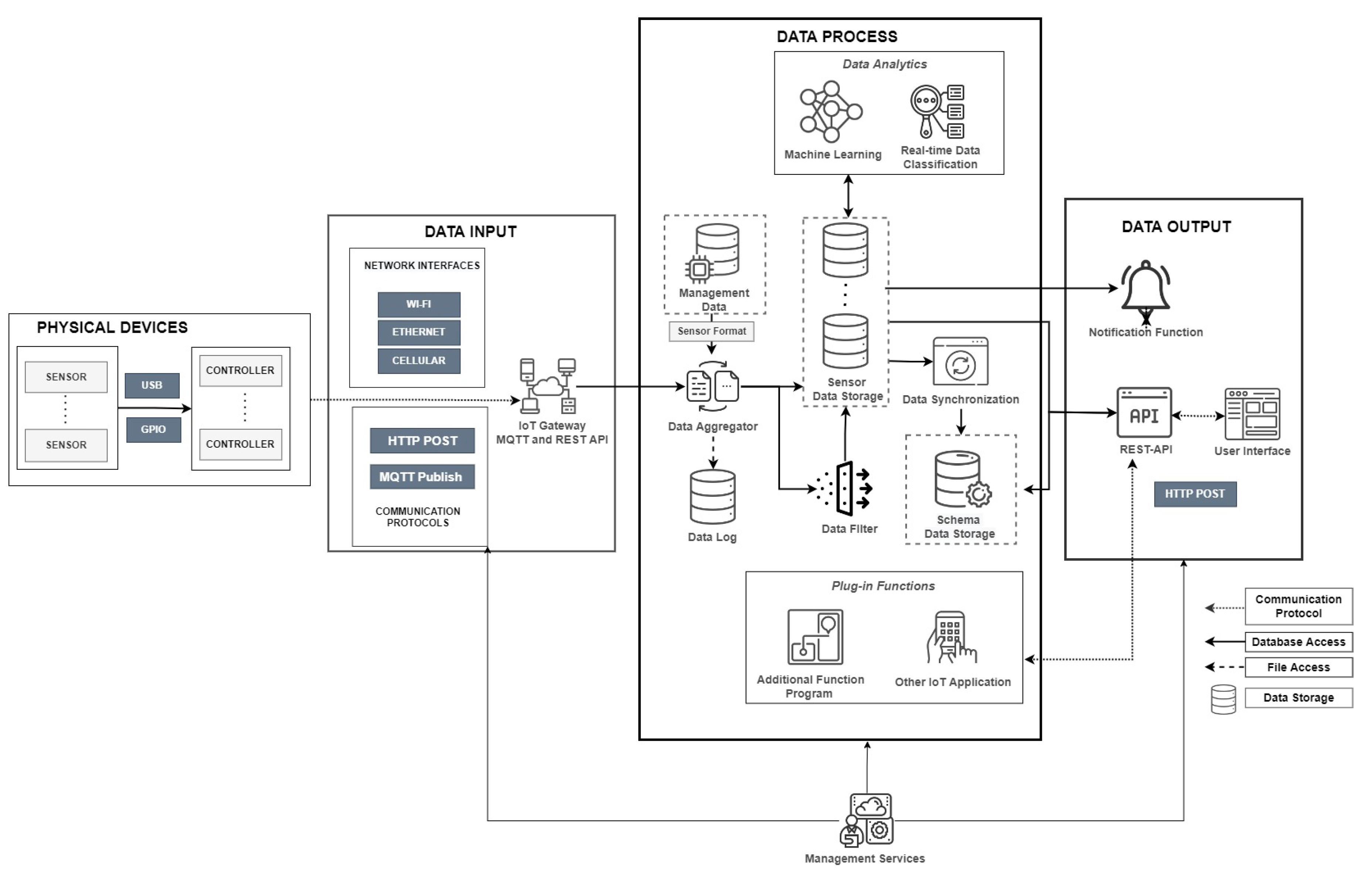

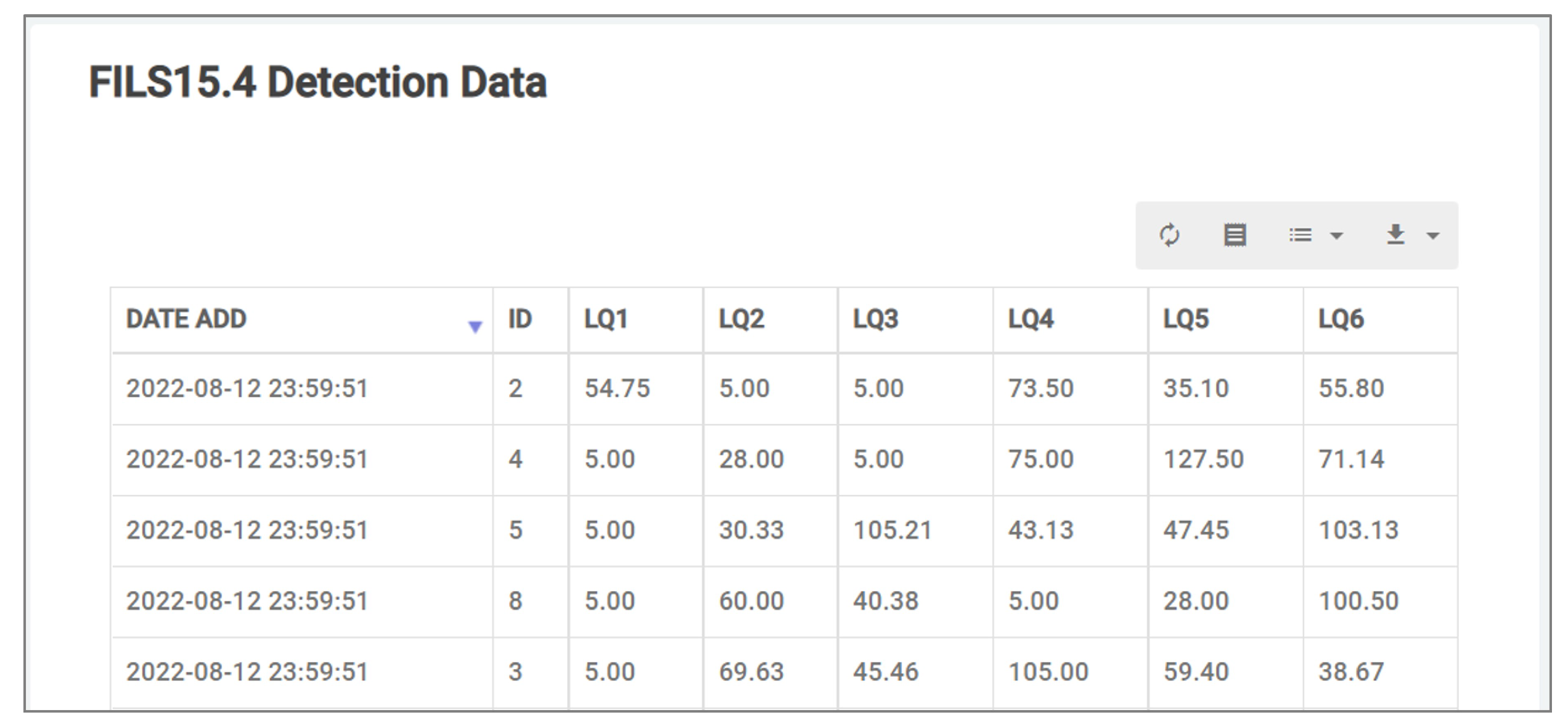
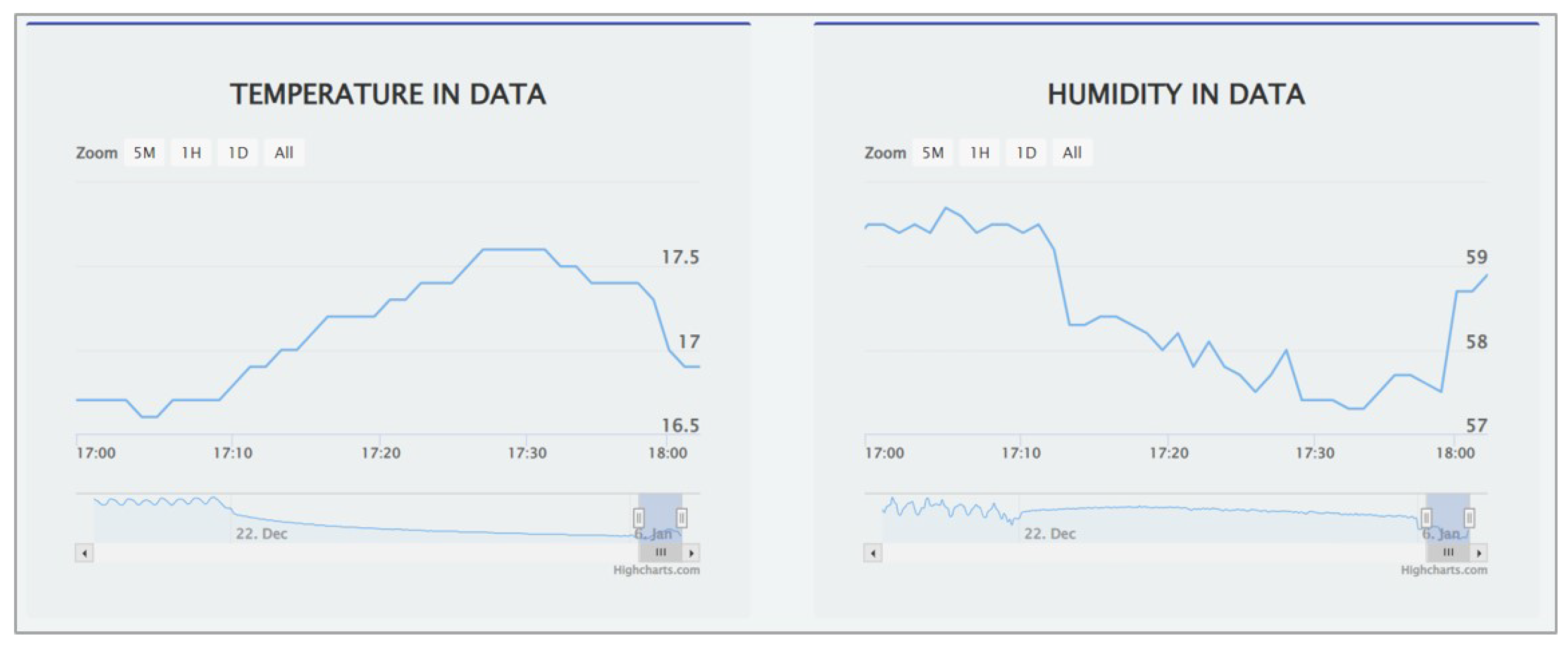
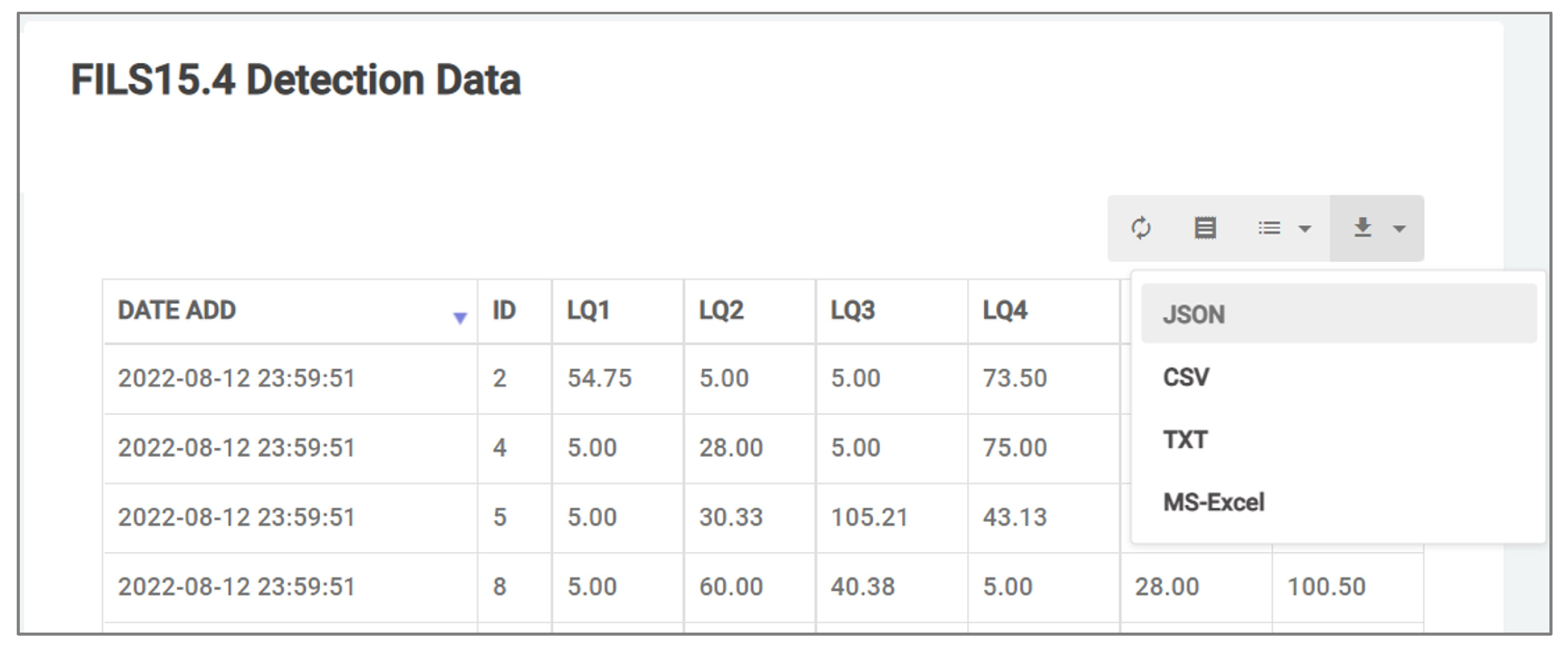


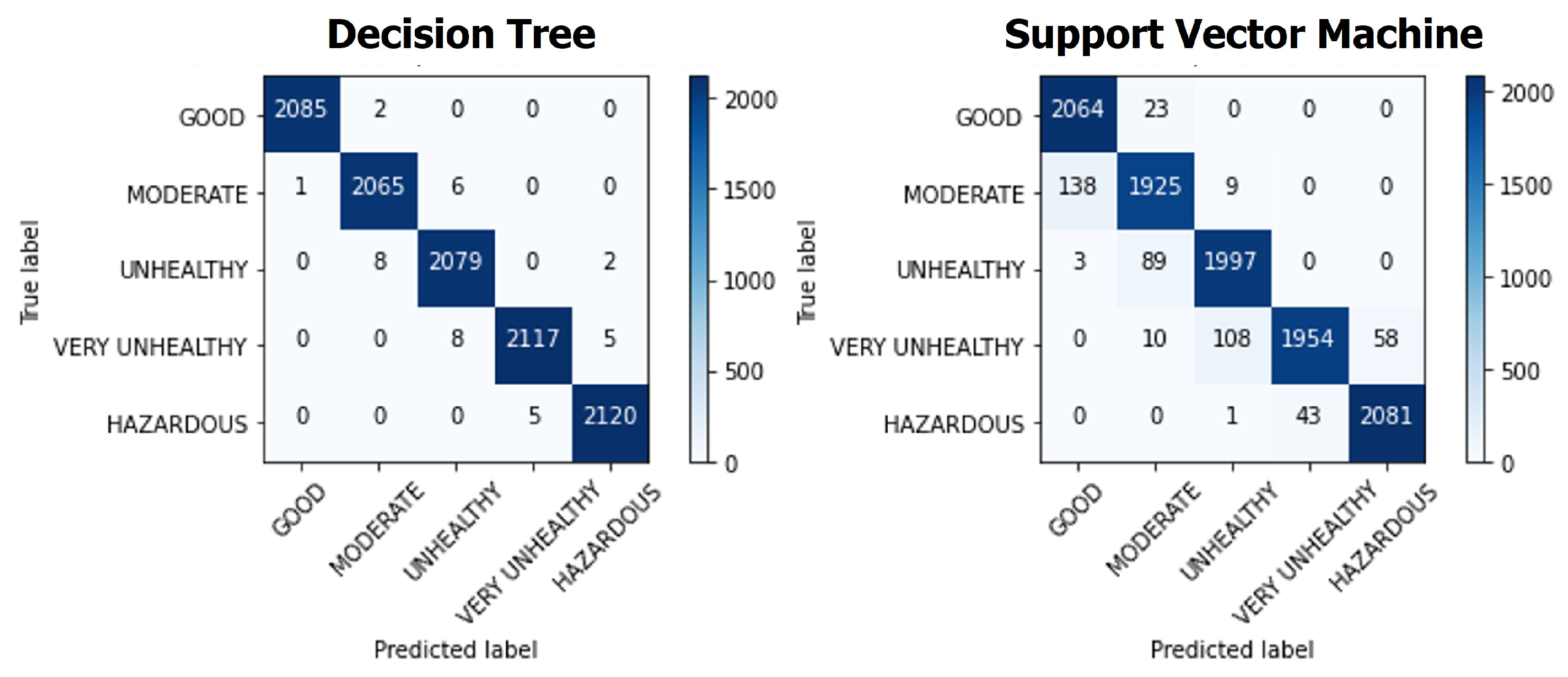
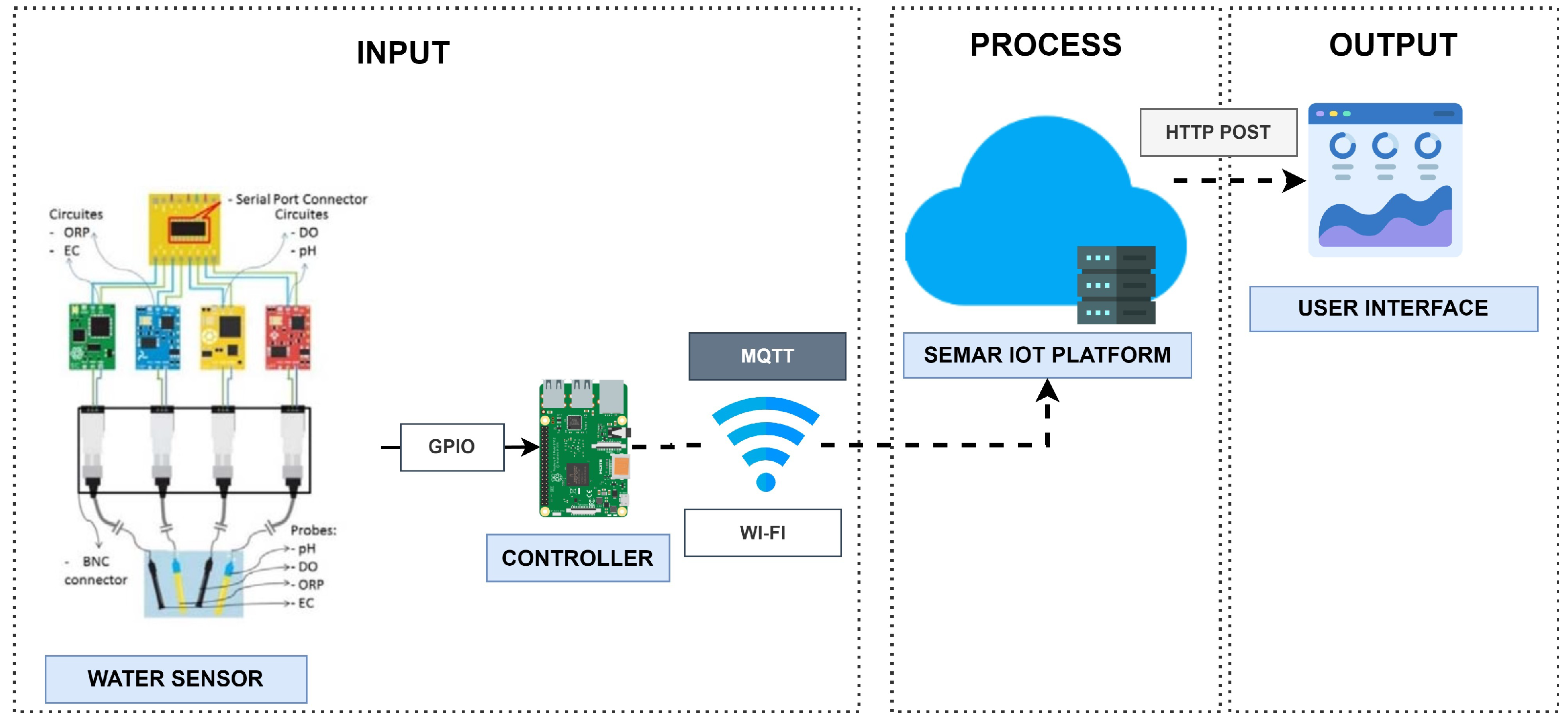

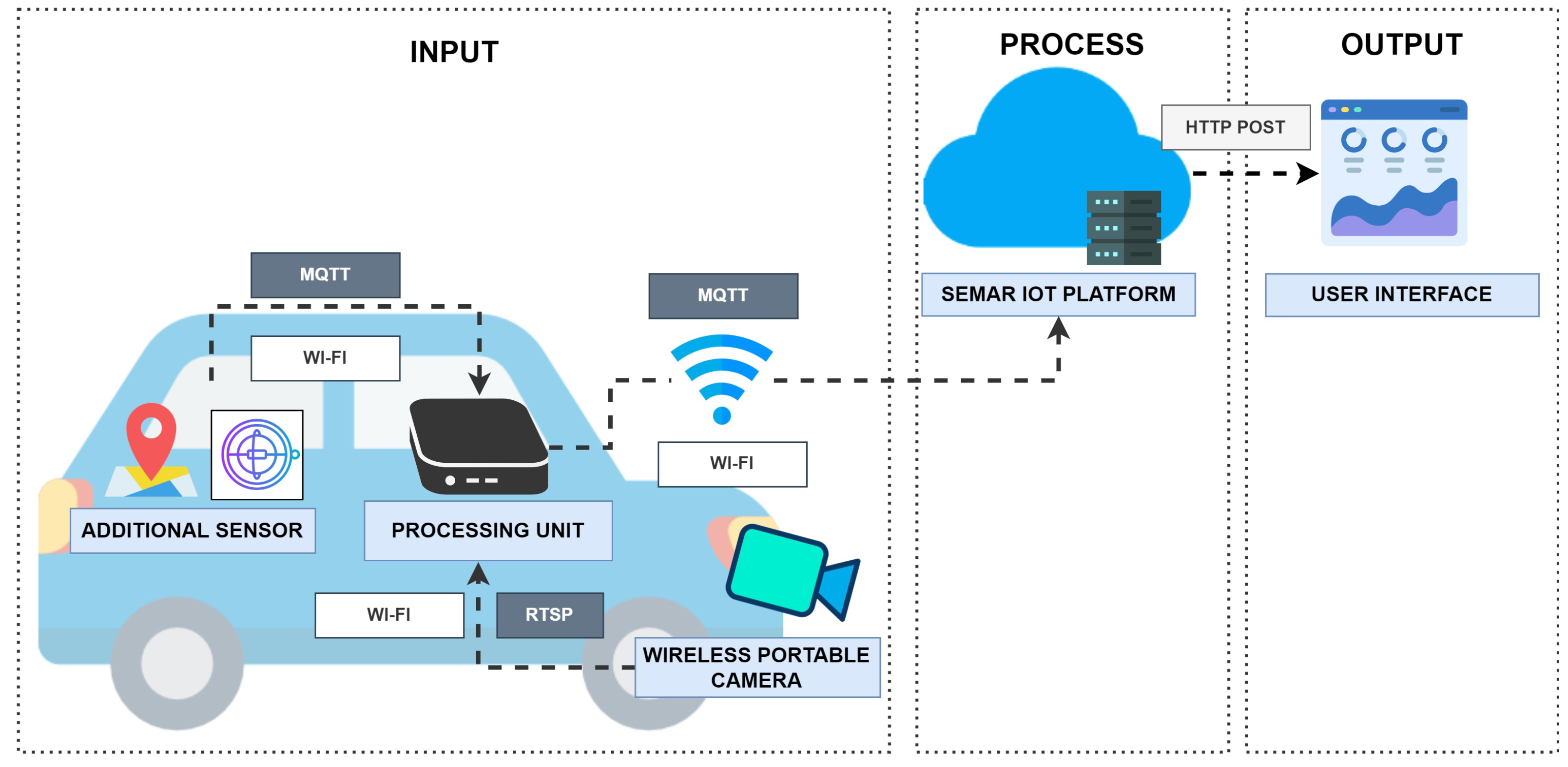




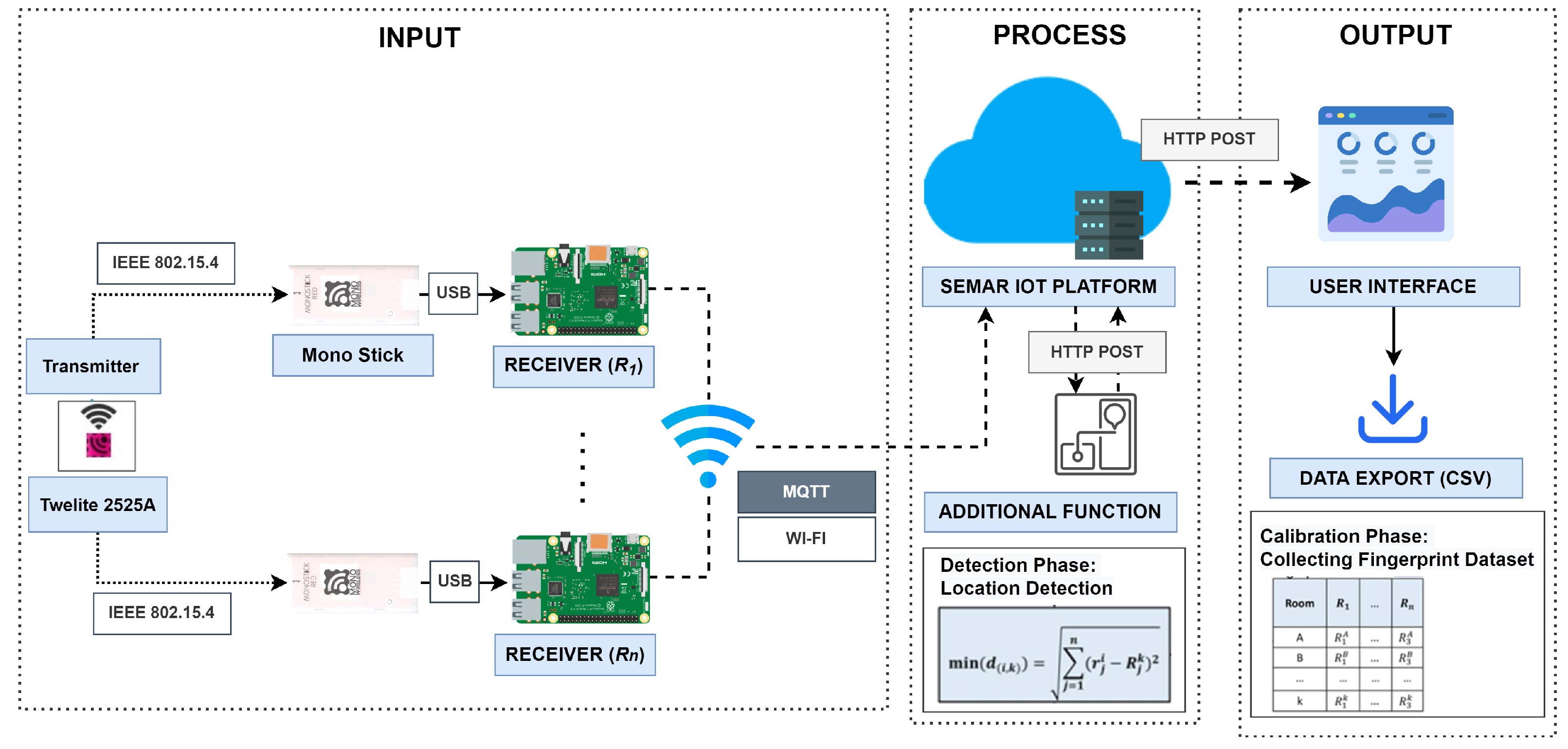


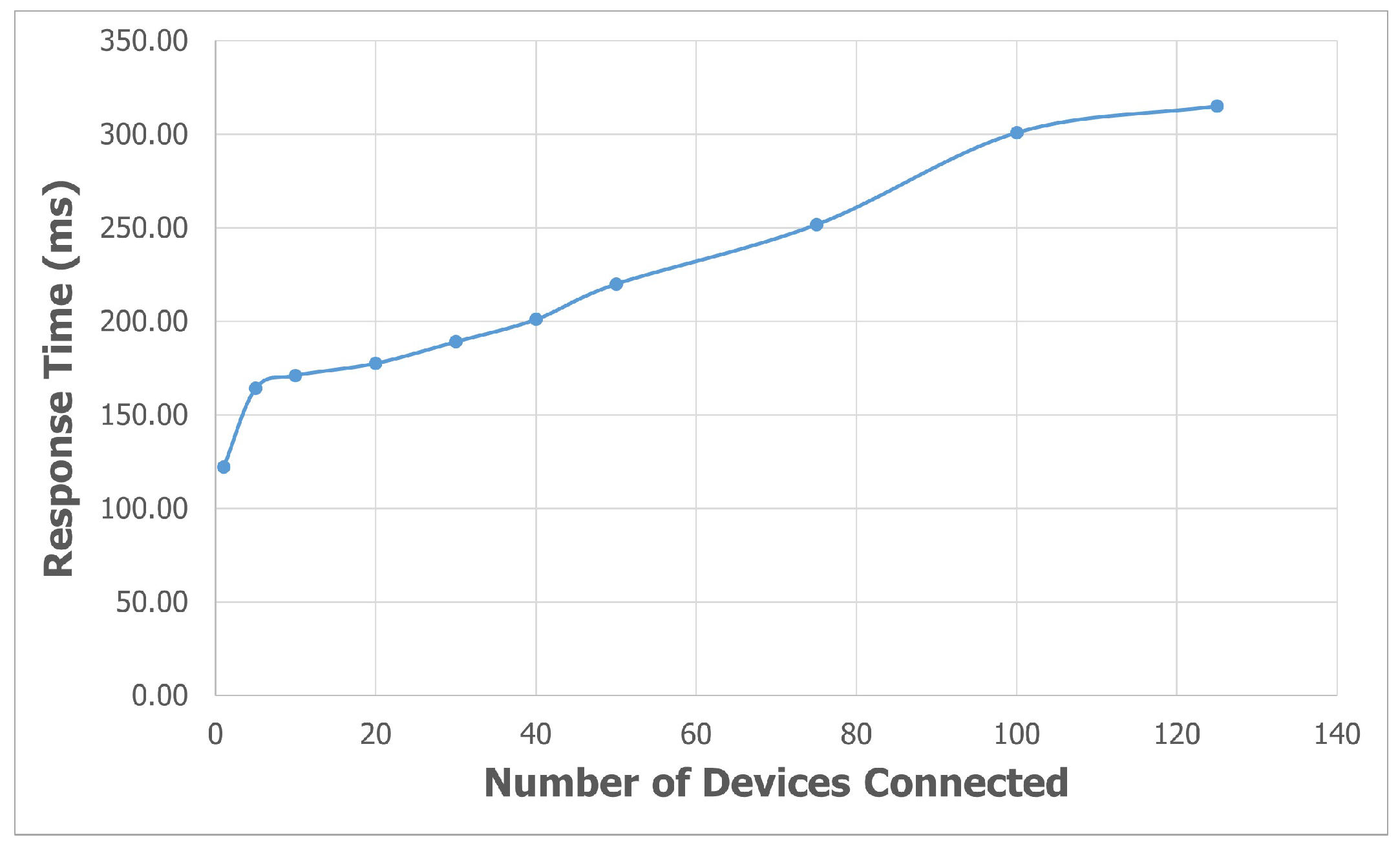
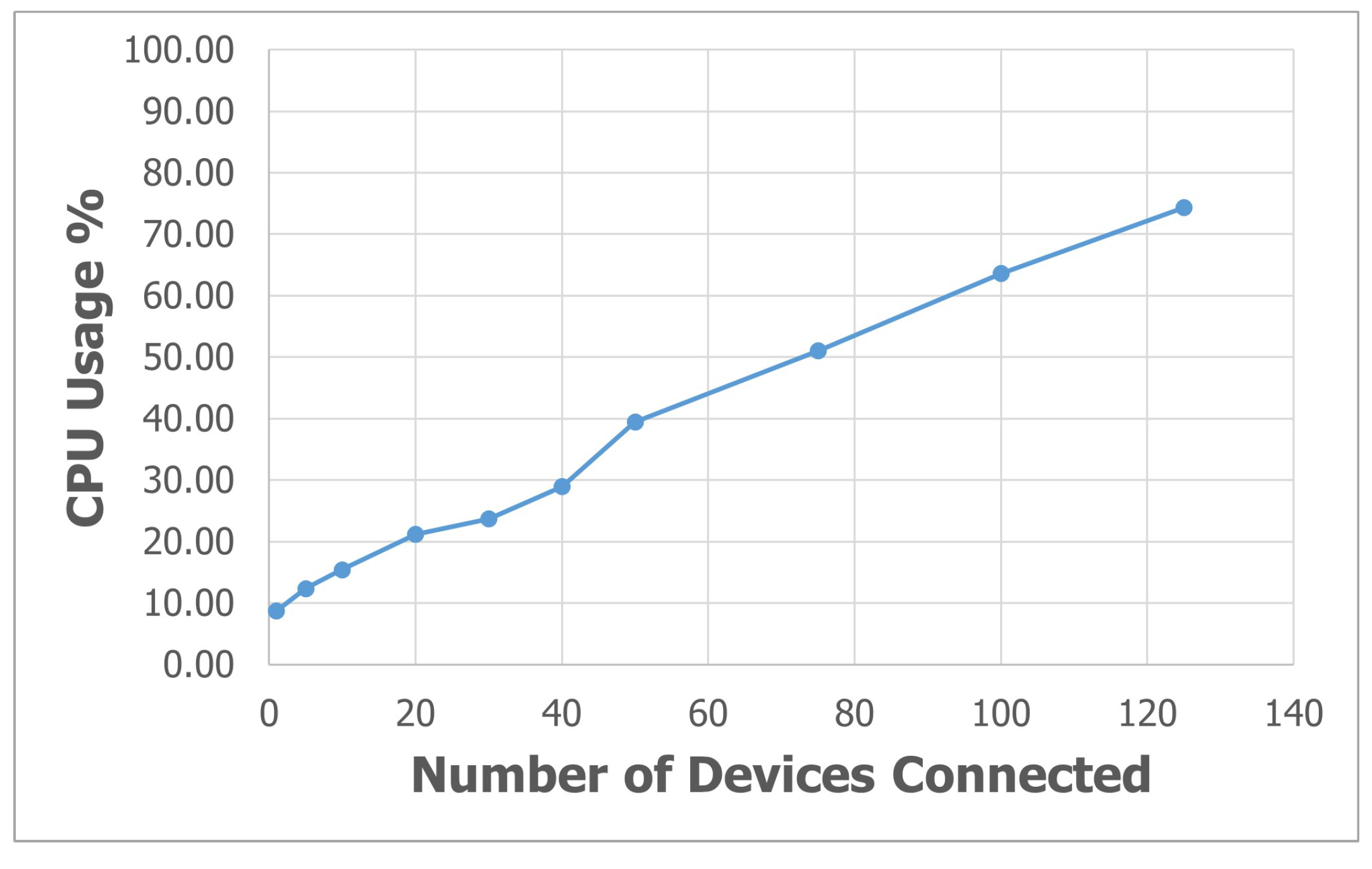
| Parameters | Description |
|---|---|
| Decision Tree algorithm: | |
| t | the node of decision tree |
| n | number of targets classes |
| the probability of the specific data class i in node t | |
| Support Vector Machine algorithm: | |
| the class label of dataset | |
| the learned weight | |
| the support vector | |
| x | the labeled training sample data. |
| the kernel function | |
| Radial Basis Function kernel: | |
| l | the length scale of the kernel RBF |
| the Euclidean distance between and |
| IoT Model | Function | Component | Description |
|---|---|---|---|
| Input | MQTT | MQTT Broker MQTT Supports | Mosquitto v2.0.10 MQTT v5.0, v3.1.1, and v3.1 |
| REST API | Libraries and Framework Communication Supports | Tornado Web Server, PyMongo, JSON HTTP-POST | |
| Network Interfaces | Network Interfaces Supports | Wi-Fi, Ethernet, Cellular | |
| Process | Server | Operating System Memory | Ubuntu 18.04.5 LTS 6Gb |
| Data Storage | Services | MongoDB v3.6.3 | |
| Data Aggregator | Libraries and Framework Communication Supports | Tornado Web Server, PyMongo, JSON, Paho HTTP-POST and MQTT | |
| Data Filter | Libraries and Framework | PyMongo, JSON, Numpy, Scipy and KalmanFilter | |
| Data Synchronization | Libraries and Framework | PyMongo, JSON, Pandas, Statistics and Threading | |
| Machine Learning and Real-time Data Classification | Libraries and Framework | sklearn, Pandas, PyMongo, JSON, and Threading | |
| Output | User Interfaces and Data Export | Programming Language Libraries and Framework Web services Development Pattern Supported browsers | PHP, CSS, HTML and Javascript CodeIgniter, Bootstrap, JQuery, HighChart JS, DataTables, OpenStreetMap Apache v2.4.29, PHP 7.2.24 MVC Google Chrome, Firefox, Opera |
| REST API | Libraries and Framework Communication Supports | Tornado Web Server, PyMongo, and JSON HTTP-POST | |
| Notification Functions | Libraries and Framework Notification supports Email Service | PyMongo, JSON, Paho, smtplib Email and MQTT Postfix | |
| Management | Management Services | Libraries and Framework Communication Supports | Tornado Web Server, PyMongo and JSON HTTP-POST |
| Features | Algorithm | Mislabel | Accuracy | MSE |
|---|---|---|---|---|
| Air Quality | Support Vector Machine | 605/10,053 | 0.94239 | 0.05761 |
| Decision Tree | 43/10,053 | 0.99591 | 0.00409 |
| Component | Specification |
|---|---|
| Operating System | Windows 10 Enterprise, 64-bit |
| Processor | AMD Ryzen 5 3550H |
| RAM memory | 8.0 GB |
| Machine Learning Library | Scikit-learn [55] |
| Machine Learning Method | Support Vector Machine and Decision Tree |
| Datasets | 25,000 rows air quality data (5 labels, 5 features) |
| Features | Algorithm | Mislabel | Accuracy | MSE |
|---|---|---|---|---|
| Water Quality | Support Vector Machine Decision Tree | 289/45,397 34/45,397 | 0.9936 0.9993 | 0.0064 0.0007 |
| Work Reference | IoT Application | Device Management | Data Synchronization | Data Filter | Decision-making assistance | Flexibility | Interoperability | Scalability | Communication Protocol |
|---|---|---|---|---|---|---|---|---|---|
| [17] | Indoor Air Quality | ✓ | ✗ | ✗ | ✗ | ✓ | ✗ | ✓ | HTTP |
| [64] | Smart Agriculture | ✓ | ✗ | ✗ | ✓ | ✓ | ✓ | ✓ | MQTT |
| [18] | Air Pollution | ✓ | ✗ | ✗ | ✓ | ✗ | ✗ | ✓ | HTTP |
| [19] | Water Management | ✓ | ✗ | ✗ | ✗ | ✗ | ✗ | ✓ | HTTP |
| [65] | Water Management | ✓ | ✗ | ✗ | ✓ | ✓ | ✓ | ✓ | MQTT |
| [21] | Air Pollution | ✓ | ✗ | ✗ | ✗ | ✓ | ✓ | ✓ | MQTT |
| [66] | Indoor Air Quality | ✓ | ✗ | ✗ | ✓ | ✗ | ✓ | ✓ | MQTT |
| [67] | Smart City | ✓ | ✗ | ✗ | ✗ | ✗ | ✗ | ✓ | HTTP & AMQP |
| [68] | Smart Industry | ✓ | ✗ | ✗ | ✓ | ✓ | ✓ | ✓ | MQTT |
| [69] | Smart Agriculture and Smart City | ✓ | ✗ | ✗ | ✗ | ✓ | ✓ | ✓ | MQTT |
| [70] | Smart Farming | ✓ | ✗ | ✗ | ✓ | ✓ | ✓ | ✓ | MQTT |
| [22] | Smart Building | ✓ | ✗ | ✗ | ✓ | ✗ | ✓ | ✓ | HTTP & Web Socket |
| [71] | Smart Irrigation | ✓ | ✗ | ✗ | ✓ | ✗ | ✗ | ✓ | MQTT |
| [72] | Smart Green and Smart City | ✓ | ✗ | ✗ | ✗ | ✓ | ✓ | ✓ | HTTP, MQTT, AMQP |
| SEMAR | Various IoT applications | ✓ | ✓ | ✓ | ✓ | ✓ | ✓ | ✓ | HTTP & MQTT |
Publisher’s Note: MDPI stays neutral with regard to jurisdictional claims in published maps and institutional affiliations. |
© 2022 by the authors. Licensee MDPI, Basel, Switzerland. This article is an open access article distributed under the terms and conditions of the Creative Commons Attribution (CC BY) license (https://creativecommons.org/licenses/by/4.0/).
Share and Cite
Panduman, Y.Y.F.; Funabiki, N.; Puspitaningayu, P.; Kuribayashi, M.; Sukaridhoto, S.; Kao, W.-C. Design and Implementation of SEMAR IoT Server Platform with Applications. Sensors 2022, 22, 6436. https://doi.org/10.3390/s22176436
Panduman YYF, Funabiki N, Puspitaningayu P, Kuribayashi M, Sukaridhoto S, Kao W-C. Design and Implementation of SEMAR IoT Server Platform with Applications. Sensors. 2022; 22(17):6436. https://doi.org/10.3390/s22176436
Chicago/Turabian StylePanduman, Yohanes Yohanie Fridelin, Nobuo Funabiki, Pradini Puspitaningayu, Minoru Kuribayashi, Sritrusta Sukaridhoto, and Wen-Chung Kao. 2022. "Design and Implementation of SEMAR IoT Server Platform with Applications" Sensors 22, no. 17: 6436. https://doi.org/10.3390/s22176436
APA StylePanduman, Y. Y. F., Funabiki, N., Puspitaningayu, P., Kuribayashi, M., Sukaridhoto, S., & Kao, W.-C. (2022). Design and Implementation of SEMAR IoT Server Platform with Applications. Sensors, 22(17), 6436. https://doi.org/10.3390/s22176436











